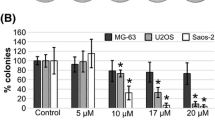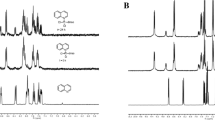Summary
Osteosarcoma treatment still is unsatisfactory owing to the development of metastases. This situation causes many problems for the patients as well as the clinicians. Tumor heterogeneity is made responsible for the development of cell lines resistant to chemotherapy. As the transplantable osteosarcoma of the rat resembles the human metastasizing osteosarcoma, studies on clones of this tumor were started. The following compounds were investigated: AMDP,cis-diammine[nitrilotris(methylphosphonato)(2-)-O 1,N 1]platinum II; DADP,cis-cydohexane-1,2-diamine[nitrilotris(methylphosphonato)(2-)-O 1,N 1]-platinum II; IMD,cis-diammine[iminobis(methylphosphonato)(2-)-O 1,N 1]platinum II; DIMD,cis-cyclohexane-1,2-diamine[iminobis(methylphosphonato) (2-)-O 1,N 1]platinum II. In vitro assays were performed with cell lines derived from a lung metastasis with the limited-dilution method. The clones varied in modal chromosome number, growth kinetics and tumorigenicity. AMDP was the most potent compound in all three clones resulting in a concentration- and time-dependent effect while IMD was somewhat less active. The diamminocyclohexane derivatives were considerably less effective, inhibiting cell growth especially in clone C10. In contrast, clone C36 was more sensitive than C25 and did not recover within the observation period of 5 days. Viability was reduced significantly only in C10, when treated with AMDP. Differences between the clones and the various compounds in inhibiting cell growth could be observed. Therefore, further experiments on the heterogeneity and sensitivity of these cell lines seem promising.
Similar content being viewed by others
References
Angres G, Scherf HR (1989) Different effects of cyclophosphamide in vivo and phosphamide mustard in vitro on two cell clones of chemically induced mammary carcinoma of the rat. J Cancer Res Clin Oncol 115:2, 203–206
Beron G, Winkler K, Beck J, Berthold F, Branders W, Gerein K, Havers W, Henze G et al. (1988) Prognosis after metastasis in osteocarcoma: experience from the COSS studies. Contrib Oncol 30:143–149
Bergerat J-P, Barlogie B, Drewinko B (1979) Effects ofcis-dichlorodiammineplatinum (II) on human colon carcinoma cells in-vitro. Cancer Res 39:1134–1338
Burchenal JH, Kalaher K, Dew K, Lokys L (1979) Rationale for development of platinum analogs. Cancer Treat Rep 63:1493–1498
Dexter DL, Spremulli EN, Fligiel S, Barbosa JA, Vogel G, Van Voorhees B, Calabresi P (1981) Heterogeneity of cancer cells from a single human colon carcinoma. Am J Med 71:949–956
Drewinko B, Brown BW, Gottlieb JA (1973) The effect ofcis-dichlorodiammineplatinum (II) on cultured human lymphoma cells and its therapeutic implications. Cancer Res 33:3091–3095
Eilam Y, Silbermann M, Szdel N (1980) Growth inhibition of clonal osteosarcoma cell-lines by low concentrations of glucocorticoid hormones. Biochem Biophys Res Commun 96:299–305
Fidler IJ (1984) Current concepts of cancer metastasis and their implications for therapy. Cancer Treat Rep 68:193–198
Fidler IJ (1987) Review: biological heterogeneity of cancer metastases. Breast Cancer Res Treat 9:17–26
Fidler IJ, Poste G (1982) The heterogeneity of metastatic properties in malignant tumor cells and regulation of the metastatic phenotype. Tumor cell heterogeneity. Academic Press, New York pp 127–145
Heppner GH (1984) Tumor heterogeneity. Cancer Res 44:2259–2265
Heppner GH, Miller BE (1983) Tumor heterogeneity: biological implications and therapeutic consequences. Cancer Metastasis Rev 2:5–23
Israel L (1990) Accelerated genetic destabilization and dormancy: two distinct causes of resistance in metastatic cells; clinical magnitude, therapeutic approaches. Clin Exp Metasasis 8:1–11
Keppler BK, Berger MR, Klenner T, Heim ME (1990) Metal complexes as antitumor agents. Adv Drug Res 19:243–310
Klenner T, Wingen F, Keppler BK, Krempien B (1990a) Phosphonates with osteotropic and antineoplastic properties — a promising perspective in the treatment of bone-related malignancies? J Cancer Res Clin Oncol (in press)
Klenner T, Wingen F, Keppler BK, Valenzuela-Paz P, Amelung F, Schmähl D (1990b) Therapeutic efficacy of two different cytostatic-linked phosphonates in combination with razoxane in the transplantable osteosarcoma of the rat. Clin Exp Metastasis 8, 345–359
Klenner T, Keppler BK, Münch H, Valenzuela-Paz P (1990c) Treatment of rat osteosarcoma with phosphonic acid linked platinum complexes in vivo and in vitro. In: Collery Ph, Parier LA, Manfait M, Etienne JC (eds) Metal ions in biology and medicine. John Libby Eurotext, Paris, pp 369–371
Lollini P, De Giovanni C, Eusebi G, Nicoletti G, Prodi G, Nanni P (1984) High-metastatic clones selected in-vitro from a recent spontaneous BALB/c mammary adenocarcinoma cell line. Clin Exp Metastasis 2:251–259
Miller BE, Miller FR, Heppner GH (1989) Heterogeneity of tumor cell sensitivities: implications for tumor responce. In: Chapman JB, Peters LJ, Withers RH (eds) Prediction of tumor treatment response. Pergamon Press, Elmsford NY, pp 227–238
Nanni P, De Giovanni C, Lollini P, Nicoletti G, Prodi G (1986) Clones with different metastatic capacity and variant selection during metastasis: a problematic relationship. JNCI 76:87–91
Nowell PC (1976) The clonal evolution of tumor cell populations. Science 194:23–28
Poste G, Greig R (1983) The experimental and clinical implications of cellular heterogeneity in malignant tumors. J Cancer Res Clin Oncol 106:159–170
Sekiya S, Iwasawa H, Yamauchi K, Kubota K, Takamizawa H (1981) Effect ofcis-dichlorodiammineplatinum (II) on cloned ovarian adenocarcinoma cells of the rat in-vitro. Gynecol Oncol 12:14–22
Souhami RL (1989) Chemotherapy for osteosarcoma. Br J Cancer 59:147–148
Tebbi CK, Gaeta J (1988) Osteosarcoma Pediat Ann 17:285–300
Tsuruo T, Fidler IJ (1981) Differences in drug sensitivity among tumor cells from parental tumors, selected variants and spontaneous metastases. Cancer Res 41:3058–3064
Vogt-Moykopf I, Meyer G, Bulzebrück H, Merkle NM, Langsdorf M (1988) Indications and long-term results in surgery of pulmonary metastases. Contrib Oncol 30:76–107
Wingen F, Schmähl D, Berger MR, Spring H (1984) Intraosseously transplantable osteosarcoma with regularly disseminating pulmonary metastasis in rats. Cancer Lett 23:201–211
Author information
Authors and Affiliations
Additional information
Dedicated to Professor Dr. D. Schmähl on the occasion of his 65th birthday
Rights and permissions
About this article
Cite this article
Klenner, T., Valenzuela-Paz, P., Keppler, B.K. et al. Sensitivity of rodent osteosarcoma clones to platinum-containing phosphonic acid complexes in vitro. J Cancer Res Clin Oncol 116, 453–458 (1990). https://doi.org/10.1007/BF01612993
Received:
Accepted:
Issue Date:
DOI: https://doi.org/10.1007/BF01612993




